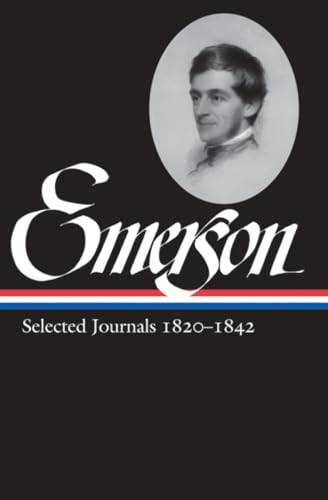Ralph Waldo Emerson: Selected Journals Vol. 1 1820-1842 (LOA #201) (Library of America Ralph Waldo Emerson Edition)
This spring has seen the publication of the 360th edition from The Library of America, in a sense completing, at least for now, the full circle of the history of American literature. The current editions are the Selected Journals of Ralph Waldo Emerson, completing the important published work of one of America’s founding thinkers.
Founded in 1979 with generous startup funding from the National Endowment and the Ford Foundation, The Library of America first published the 1,300-page Essays and Lectures to celebrate Emerson’s central position in American letters. Now in 2010, the Library of America has come full circle with Emerson’s journals.
The separation of nearly thirty years between the two Emerson editions begs the question: Why the delay in giving us the selected journals? The answer speaks to the history of Emerson studies among academics, on the one hand, and, on the other, the extraordinary popularity of Emerson among the reading public since the 1850s, when his work found a large and devoted audience.
Along with the Bible, a collection of Emerson’s essays has been for a century a fixture in most American homes, bringing inspiration, solace, encouragement, and instruction in how to live a fruitful and moral life. What was missing for the general reader was Emerson the man: the husband, the father, the friend, and the solitary seeker after the mysteries of existence. In other words, the general reader knew little about the private Emerson.
Working from his father’s copious notebooks and diaries, Edward Emerson was the first to compile the journals, completed in 1914 in ten volumes. After the family bequeathed the entire collection to Harvard, scholars soon realized that Edward had severely edited the journals, removing the private and sometimes most revealing details of his father’s life. And it was not until 1962 that Harvard University Press began a complete revision and scholarly publication, which was completed in 1982 in time for the Centennial of Emerson’s death.
The problem was and still remains that Harvard, having completed the printing of the journals in sufficient number to stock the nation’s community and university libraries, regards its task as finished. Presently, many volumes of the Harvard edition are out of print, and there is little promise that the journals will be reprinted.
The Library of America has come to the rescue, having decided that making the heart of the journals available to the general public would be a valuable contribution, hence the two-volume set presently on sale for a very reasonable price.
What we find in these pages opens the door to Emerson’s home in Concord and into the fertile mind of what some have called America’s conscience. Here is the Emerson we have come to know through the great biographies written since the Centennial in 1982, culminating in the monumental Emerson: The Mind on Fire by Robert D. Richardson, whose Thoreau: The Life of the Mind began his examination of the Concord Circle.
In these journal entries we first meet the sixteen-year-old junior at Harvard discovering his unique voice, airing his doubts, finding his connection to nature, being inspired by teachers and books, and forever wondering what he will do with the life he has been given. There is the exultation of youth as he writes, “I say to the universe, Mighty one! Thou art not my mother; return to chaos if thou wilt, I shall exist. I live. If I owe my being, it is to a destiny greater than thine.”
Then later, as a new minister, married to the frail and beautiful Ellen Tucker, he watches as she succumbs to tuberculosis at the age of nineteen, shattering their dreams of a life together.
“There is that which passes away and never returns. This miserable apathy, I know, may wear off. I almost fear when it will. Old duties will present themselves with no more repulsive face. I shall go again among my friends with a tranquil countenance. Again I shall be amused, I shall stoop again to little hopes and little fears and forget the graveyard. But will the dead be restored to me? Will the eye that was closed on Tuesday ever beam again in the fulness of love on me? Shall I ever again be able to connect the face of outward nature, the mists of the morn, the star of eve, the flowers, and all poetry, with the heart and life of an enchanting friend?”
These entries share both the heights and depths of human emotion but also teach us how to frame such outpourings in language. Emerson knew early death in his family, illness in the home, and grinding debt, and it is in the journals that we learn how he overcame tragedy, how he maintained his equanimity and learned to marshall his eloquence for the good of his countrymen.
As noted above, the cost of these volumes is reasonable, especially in the light of the quality of production: acid-free paper that is thin but sturdy, a binding that lets you open the book to lie flat, and as always, the thin green ribbon to mark your place.
It is a treasure.
